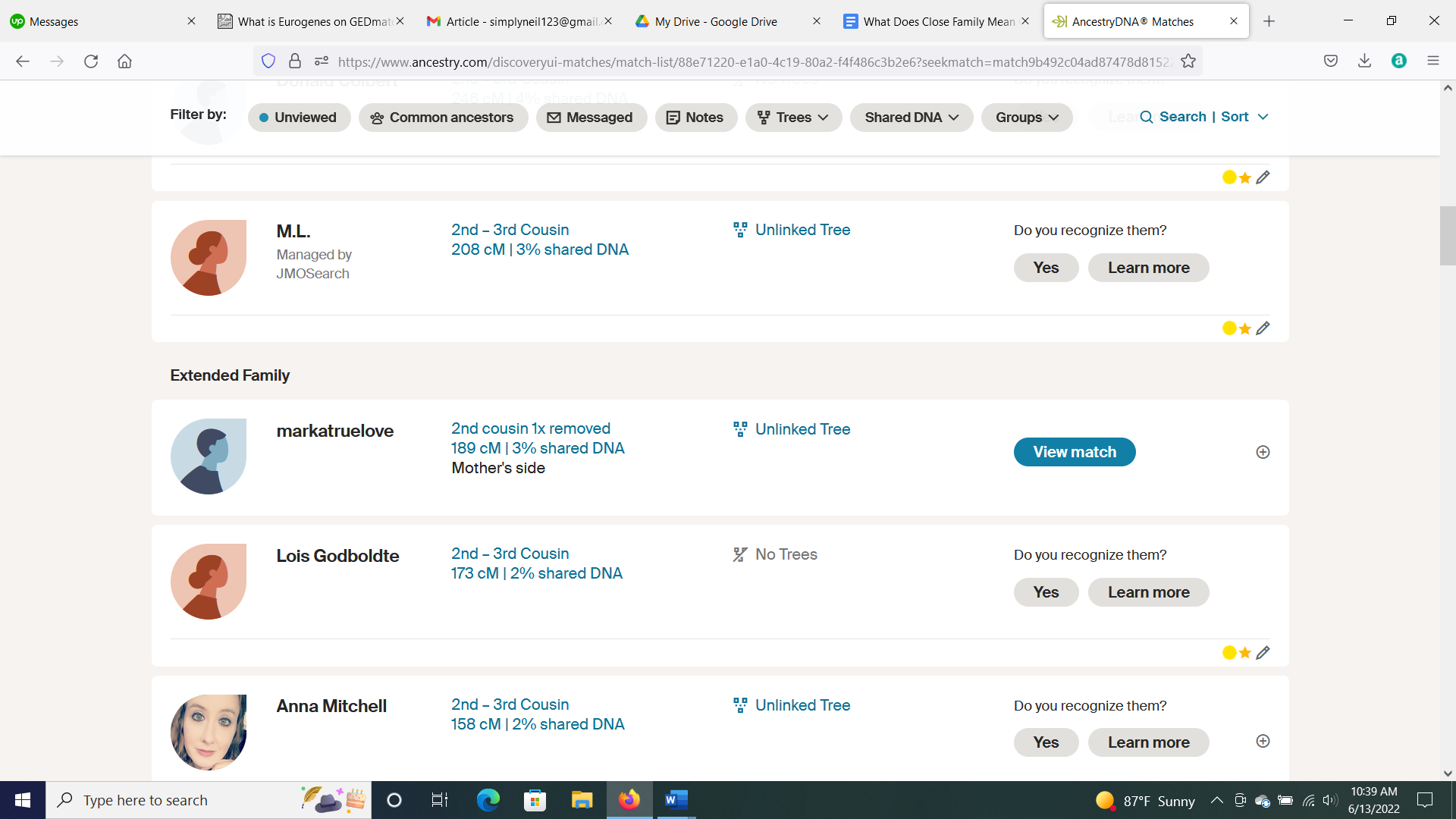What Does Close Family Mean On Ancestry DNA?
Reviewing your matches on AncestryDNA can sometimes be confusing especially when you do not know how you are related to these people. Some of us are fortunate to have known family members who have also tested so we know how we are supposed to be related to them.
There are many levels of relationship when it comes to the DNA estimates on AncestryDNA but you would think that Close relatives would not be too complicated. Actually as this post will show this might not be the case.
How We See Our Potential Relationships on AncestryDNA
If you have taken a test with AncestryDNA and your results have come in you have already seen your match list. It’s sometimes quite a long list of names with estimated relationships that is generally ordered from most shared DNA down to least.
You might also note that the matches get grouped into certain subheadings which again is based on how much DNA you share with these individuals. These include the following categories
- Self/Twin
- Parent/Child
- Full Sibling
- Close Family
- Extended Family
- Distant Family

In this post we are going to focus on those who fall in the close family range to try and determine who they should be according to Ancestry.
AncestryDNA Match Categories
When you search the Ancestry site specifically the resource pages you are going to struggle to find a definitive answer to what constitutes close family. One of the first pages I found was titled “AncestryDNA Match Categories.”
According to that article, close family matches start at around 2,200 centimorgans which is somewhere in the region for a low match to a full sibling. Having reviewed the very extensive list of matches I have in my own list I note that my lowest close family match is 208 centimorgans.
The next match in my list shares 189 centimorgans of DNA with me and is listed as an extended family match. So from this I can assume that somewhere between 208 and 189 centimorgans there is a cutoff where close family matches become extended family.

The problem is that Ancestry resource pages do not indicate where this point is exactly. What they do indicate is that a shared DNA of 90-340 centimorgans is in the range of second to third cousins. This means that that close family cutoff which must be between 189-108 centimorgans is right in the middle of the second to third cousin territory.
Who Are Considered Close Family?
In terms of AncestryDNA then the first people who might be considered in the close family range would be a half sibling. This is because a full sibling has their own category. Half siblings of course only share one of your biological parents so they share less DNA with you than your full siblings would.
Others who are within the top tier of close relatives would include aunts, uncles, nieces, nephews, grandparents and grandchildren. Essentially people that you would consider among your closest relatives anyway.
Based on the amount of DNA shared it is safe to assume that most first and second cousins should also show up as close relatives on your DNA matches list. I have a couple of first cousins who I actually discovered through Ancestry who are on my own list.
I was able to determine that the first extended family member on my own list is my first cousin twice removed in terms of actual relationship.
Where Is the Cutoff for Close Family?
As mentioned, Ancestry does not expressly state anywhere the exact cutoff between close family and extended family although observations would indicate it is around 200 centimorgans of shared DNA. As shared DNA does not always indicate a specific relationship it is hard to determine exactly who should be a close family.
A second cousin may share less than 200 centimorgans of DNA with us and be considered extended family while a third cousin may share more than 200 and be considered close family. This is of course all just on the genetic level.
Ancestry Is Confusing Us
The truth is that some of the resource pages you find on Ancestry have differing definitions and ranges in terms of potential familial matches. In fact none of those I found actually completely tally with how matches are grouped on our list of matches.
This isn’t of course deliberate because in all honesty we should cut Ancestry a little slack here. They are constantly upgrading and updating their DNA techniques to get better and more accurate results and estimates.
The genetic match goalposts are constantly shifting and of course most of their resource articles are likely years behind the updates that have taken place.
How Important Is Knowing Who Close Family Are?
In terms of our AncestryDNA matches list I would suggest that it isn’t exactly vital to differentiate between close and extended family on the shared DNA level. As I mentioned, a third cousin might share more DNA with you than a second cousin.
On paper you are more closely connected to the second cousin but you have more DNA in common with the third cousin. In a situation like this the close family label does not mean a great deal. What is important is being able to use our DNA results in connection with good old fashioned genealogy to try and find out how exactly we are related.
Conclusion
Ancestry does not expressly define close family in a consistent way. The truth is there are some contradictory assessments of it throughout the site. Studies of how they group our cousin matches however indicate that the close family section ranges between 2,200 and 200 centimorgans of shared DNA.
Above this range we have full siblings, parents and twins. As we get below this range we have extended family which may include second, third and below cousin levels. Ultimately though what matters most is how much DNA we share with these matches and whether or not we can determine how we are related to them.
Link To or Reference This Page
We spent a lot of time downloading, cleaning, merging, and formatting the data that is shown on the site.
If you found the data or information on this page useful in your research, please use the tool below to properly cite or reference Name Census as the source. We appreciate your support!
-
<a href="https://namecensus.com/blog/what-does-close-family-mean-on-ancestry-dna/">What Does Close Family Mean On Ancestry DNA?</a>
-
"What Does Close Family Mean On Ancestry DNA?". NameCensus.com. Accessed on April 24, 2024. https://namecensus.com/blog/what-does-close-family-mean-on-ancestry-dna/.
-
"What Does Close Family Mean On Ancestry DNA?". NameCensus.com, https://namecensus.com/blog/what-does-close-family-mean-on-ancestry-dna/. Accessed 24 April, 2024
-
What Does Close Family Mean On Ancestry DNA?. NameCensus.com. Retrieved from https://namecensus.com/blog/what-does-close-family-mean-on-ancestry-dna/.
